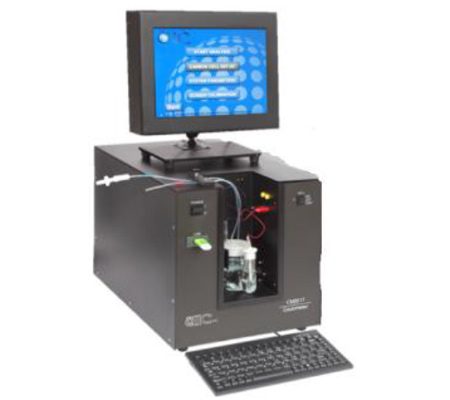CARBON DIOXIDE COULOMETER

The analysis of carbon in a wide variety of materials continues to be a concern for many industries. Complex matrices and widely varying concentrations, from ppm to 100%, result in a challenging task for the analyst. The UIC, Inc. CO2 Coulometer can be the solution to most carbon analysis applications by rapidly and directly determining carbon dioxide from a variety of sources.
PRINCIPLES OF OPERATION
The coulometer cell is filled with a partially aqueous medium containing ethanol amine and a colorimetric indicator. When a gas stream passes through the solution, CO2 is quantitatively absorbed. CO2 reacts with the ethanol amine to form a strong titratable acid which causes the indicator color to fade. The titration current automatically turns on and electrically generates base to return the solution to its original color. This 100% efficient coulometric process gives results in basic theoretical units (coulombs) so calibration using standards is not required (unlike absorption tube weighing, IR, TC, FID and other empirical techniques). The linear range and accuracy (better than 0.20% relative standard deviation for standard materials) of the coulometer generally exceeds that obtained by other detection methods.
The Model CM5017 CO2 Coulometer includes proportionally controlled circuitry to decrease the current as the end point is approached. The cell current is integrated and displayed on a digital readout in a number of operator selectable units (such as micrograms C, micrograms CO2, and micrograms CO3). The CM5017 CO2 Coulometer calculates the composition automatically and prints a summary report. Data can be archived to a 3.5″ floppy diskette where it is stored in text file format (i.e., *.TXT) for easy exportation to most popular word processing and/or spreadsheet programs.
EASE OF OPERATION
The colorimetric end point allows for highly reliable operation. The cell inlet is designed to accept 1/8 inch o.d. Teflon®, polyethylene or stainless steel tubing. There are no difficult adjustments required for normal operation of the coulometer. The coulometer is highly stable and the internal calibration allows results to be immediately obtained. The CO2 Coulometer is equipped with RS232C and parallel interfaces for use with peripheral equipment.
RANGE & RATE
The working range of the CO2 Coulometer is from less than one microgram C up to 10,000 micrograms of carbon for a single sample (with 1000 – 3000 ug C being the optimal carbon concentration). The coulometer cell solution has an absorbance capacity of over 100 mg for a single cell filling, typically allowing a full day of analyses without a need to replace the cell solution. Titrating at its maximum current (200ma), the CO2 Coulometer can titrate approximately 1500 micrograms of carbon (or 5500 ug of CO2) per minute. The sample size is adjusted to give appropriate amounts of CO2 to provide high accuracy determinations in reasonable periods of time.
INTERFERENCES
A variety of carrier gases, including oxygen, nitrogen, helium and air, can be used with the coulometer. Many reactive gases can interfere with the coulometer operation. Basic gases can be removed with an acid scrubber. Acidic and other gases, including SO2, SO3, H2S, HCl, HBr, HI, Cl2 and NOx, can be effectively removed using scrubbers such as KI, Ag2SO4, AgNO3 and MnO2. Although the CO2 Coulometer can be thought of as a “digital carbon absorption tube” with similar interferences, some substances such as water will not interfere with the coulometer but will with absorption tubes.
ABSORPTION EFFICIENCY
The effect of carrier gas flow on absorption has been evaluated using the Model CM5330 Acidification Unit. At flow rates of 1 to 200 cc per minute, absorption efficiencies of greater than 99.9% are obtained.
APPLICATION
The UIC, Inc. CO2 Coulometer has been used for a wide variety of CO2 measuring applications. A few typical applications are described below, and Table I summarizes typical results.
- TOTAL CARBON IN ORGANIC MATERIALS
The CO2 Coulometer is used as a detector with digital readout for carbon determinations in elemental microanalysis. The UIC, Inc. Combustion Apparatus options can be used to oxidize carbon to CO2. Depending on the efficiency of the combustion system, the wide dynamic range of the coulometer allows for somewhat larger or smaller than usual samples to be used.
- TOTAL CARBON IN OTHER MATERIALS
The CO2 Coulometer has been used to measure CO2 from the combustion of organics and the decomposition of carbonates in soils, rocks, sediments and inorganic substances. Carbon concentrations down to ppm levels can be obtained by using relatively large samples. Effective scrubbing systems have been developed for determining total carbon in reactive substances such as elemental sulfur and molybdenum sulfide. See Coulometrics Application Note #10 (CAN-10) for more detailed information on determinations of TC in solids and sediments.
- TOTAL CARBON, TOTAL ORGANIC CARBON (TOC) & DISSOLVED ORGANIC CARBON (DOC) IN WATER
The CO2 Coulometer and the Horizontal Combustion Apparatus have been used to determine carbon in water using both ladle introduction and syringe injection. Since tedious calibration of the CO2 Coulometer is not required, the determination of DOC and TOC is greatly simplified. The linear range and integrating characteristics of the coulometer allow results to be independent of combustion rate or the rate of CO2 transfer. See CAN-2 for more detailed information on the determination of TC, TOC, and DOC in water.
- CARBONATE (INORGANIC) CARBON
The CO2 Coulometer and the Acidification Unit have been used to determine carbonate carbon in a variety of samples including pure carbonates, soils, rocks, oil, shale oil, water, industrial wastes, amine solutions and flour. A few samples, such as dolomitic limestone, are notably slow to release their inorganic carbon even in hot acid. With the CO2 Coulometer, the slow rate of CO2 release can be readily monitored and the end point accurately determined. See CAN-3 for more detailed information on determinations of carbonate carbon.
- ORGANIC OXYGEN
The CO2 Coulometer has been used as a detector for Unterzaucher / Schutze oxygen determinations. The use of the coulometer eliminates the need for tube weighing or gas mixing for thermal conductivity. Results with greatly improved reliability, accuracy and speed are obtained. See CAN-4 for more detailed information on determinations of organic oxygen.
- CARBON DIOXIDE IN GASES
The CO2 Coulometer has been used to monitor and measure CO2 in air, stack gases and respiratory gases. Contact the UIC, Inc. Applications Laboratory for details on specific applications.
- ORGANIC CARBON IN HIGH CARBONATE SOLIDS
The CO2 Coulometer can be used with the Combustion Apparatus options to determine organics in high carbonate solids. Samples are combusted at temperatures below the decomposition temperatures of the carbonates. If bicarbonates are present, preheating the sample is required to decompose them to carbonates.
- SURFACE CARBON
The CO2 Coulometer can be used with the Horizontal Combustion Apparatus to determine surface carbon on a variety of samples including steel, substrates, glass and silver filters. Use of the CO2 Coulometer’s direct detection is especially advantageous with such samples because standards are difficult or impossible to prepare. See CAN-7 for more detailed information on surface carbon determinations.
TABLE I.
TYPICAL RESULTS USING THE UIC, INC. CO2 COULOMETER
WITH A VARIETY OF SYSTEMS
Method | Sample | Theory %C | Found C% | # of Runs | Range from Ave. %C |
| Total Carbon | Acetanilide | 71.09 | 71.05 | 11 | +/- 0.22 |
| Sucrose | 42.10 | 42.10 | 5 | +/- 0.09 | |
| Triphenylmethane | 93.40 | 93.26 | 7 | +/- 0.21 | |
| Benzylisothio-urea-HCl | 47.40 | 47.43 | 2 | +/- 0.12 | |
| P-Nitroaniline | 52.17 | 52.13 | 2 | +/- 0.00 | |
| M-Dinitrobenzene | 42.86 | 42.75 | 2 | +/- 0.015 | |
| Calcium Carbonate | 12.00 | 12.01 | 8 | +/- 0.04 | |
| Sulfur | —— | 0.0062 | 3 | +/- 0.0005 | |
| Alumina | —— | 0.0001 | 2 | —— | |
| Magnesium Hydroxide | —— | 0.0102 | 3 | +/- 0.0005 | |
| Paraffin | —— | 85.25 | 4 | +/- 0.12 | |
| Carbonate Carbon (Inorganic) | Calcium Carbonate | 12.00 | 12.00 | 10 | +/- 0.05 |
Direct Injection to Coulometer | Air | 0.50 | 0.50 | 3 | +/- 0.0005 |
Total Carbon Syringe Injection | Benzoic Acid Solution Retort Water | 9.7 ppm —— | 9.5 ppm 9540.0 ppm | 4 2 | +/- 0.4 ppm +/- 30.0 ppm |
| Total Surface Carbon on Steel | Dioctyl Sebacate | 73.2 mg/m2 | 74.4 mg/m2 | 3 | +/- 1.6 mg/m2 |
| Oxygen | Benzoic Acid Methanol Blend | 26.21 %O 1.03 %O | 26.26 %O 1.00 %O | 7 3 | +/- 0.27 %O (SD) 0.006 %O |
| 2.81 %O | 2.75 %O | 3 | (SD) 0.010 %O | ||
| 5.08 %O | 5.01 %O | 3 | (SD) 0.006 %O | ||
| Ethanol Blend | 2.78 %O | 2.75 %O | 3 | (SD) 0.006 %O | |
| Isopropanol Blend | 2.81 %O | 2.79 %O | 3 | (SD) 0.006 %O | |
| MTBE Blend | 2.74 %O | 2.73 %O | 3 | (SD) 0.006 %O |




